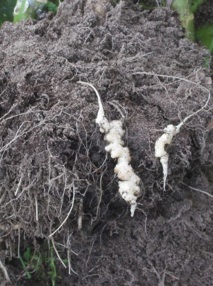
Features
Production
Research
Vegetable producers urged to check for clubroot
July 15, 2008 By Alberta Agriculture. Food and Rural Development
 NEWS HIGHLIGHT
NEWS HIGHLIGHT
Vegetable producers urged to check for clubroot
Alberta scientists are asking that vegetable growers in that province
watch for symptoms of clubroot in cole crops.
July 15, 2008, Brooks, Alta – Many vegetable growers in B.C. and in central and eastern Canada already know that clubroot can be a big problem in cole crops.

|
| Clubroot on cauliflower. |
Because clubroot was found in two cabbage fields in the Edmonton area last year, scientists are asking that Alberta growers watch for symptoms of clubroot in crops such as broccoli, Brussels sprouts, cabbage, cauliflower, Chinese cabbage, kale, kohlrabi, radish, rutabaga and turnip this growing season. Clubroot doesn’t usually affect other types of vegetables that are grown in Alberta.
“Clubroot is becoming a fairly widespread disease in central Alberta in canola, so it would be wise for vegetable growers in that area to examine their crops for the characteristic symptoms of this disease,” says Dr. Ron Howard, plant pathology research scientist with Alberta Agriculture and Rural Development, based in Brooks, Alta. “Surveys have been done to check for clubroot in canola and vegetable fields in Alberta since 2003. Fortunately, clubroot has only been found in two vegetable fields, one a very minor infestation and the other was more extensive which resulted in some economic loss. Currently, this is a relatively minor problem to Alberta’s vegetable industry overall and we’d like to keep it that way.”
From now until harvest is when growers should be scouting their crops and checking for above-ground symptoms of clubroot, things such as wilting, yellowing, stunting of crops, or other indications that there could be a problem. If any of these symptoms are noticed, growers can use a garden fork and dig up the roots to examine the plants further. If there are large galls on the roots, it is a good indication that the problem is clubroot.
“Alberta Agriculture’s specialists are willing to work one-on-one with growers to help keep this disease from spreading,” says Dr. Howard. “Growers are encouraged to contact Alberta Agriculture and Rural Development or their local ag service board fieldman if they find clubroot in their vegetable crops. Specialists in the province are tracking clubroot to determine how extensive it is and are collecting samples to determine races or pathotypes. Most importantly, specialists are working with growers to help them develop management strategies to minimize future losses.”
Growers who suspect clubroot infestation can also send a sample to one of the commercial plant health labs in Alberta for confirmation. The labs that do clubroot confirmations and genetic analysis of the plant tissue are 20/20 Seed Labs in Nisku and BioVision Seed Labs in Edmonton.
Clubroot can go unnoticed as it is a below-ground problem, although it does manifest symptoms above ground. It is important that growers know what to look for so that they can spot this disease early and take steps to confine it to the location where it is found. Clubroot can be spread easily with soil infested with spores adhering to tillage equipment. Growers who don’t realize that they have clubroot can unknowingly spread the disease to other parts of their farm.
“We encourage growers to rotate away from the cole crop vegetables if they do have clubroot,” says Dr. Howard. “Generally, a crop rotation of between four and six years is recommended between successive cole crops to minimize the risk of clubroot build-up.”
Alberta Agriculture and Rural Development has produced several fact sheets that growers and other interested people can refer to for information on clubroot and for advice on managing this disease. These free fact sheets can be ordered from Alberta Agriculture’s Publications Office by calling toll-free 1-800-292-5697 or can be downloaded from the department’s website at www.agriculture.alberta.ca/publications.
Print this page